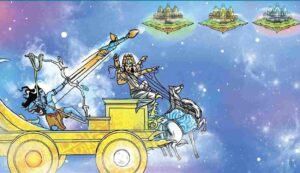Know how Tripurasura was killed and the mythological story behind it
Killing of Tripurasura: Tripurantaka is another name for Lord Shiva. Mahadev’s murder of Tripurasura earned him this moniker. The Karnaparva of the Mahabharata has a detailed account of the murder of Tripurasura. It is crucial to understand that Tripurasura is the name of three strong demons: Tarakaksh, Kamalaksh, and Vidyunmali. It was not the name of a single demon. These demons were the offspring of the powerful demon Tarakasura, who was slain by Lord Shiva and Parvati’s son Kartikeya. The three sons carried out intense penance to appease Lord Brahma in order to get revenge for the murder of their father.

Boon and Penance
Brahma was pleased by Tripurasura’s penance and dedication and bestowed a blessing upon him. He was able to construct three impregnable, floating cities known as Tripura because of this gift. Only once per thousand years did they align in a straight line and float in the sky. The boon said that only when they were lined up and hit by a single arrow could they be destroyed. With his invincible cities, the Tripurasuras gained great power and conceit. By assaulting the gods and causing chaos, he wreaked disaster over the cosmos. The gods were powerless and in dire need of a remedy, as they could not handle the devastation the Tripurasuras had inflicted.
Asking Shiva for assistance
For assistance, the gods looked to Lord Shiva. Known for his strength and kindness, Shiva consented to help them but awaited the exact time when the three cities would line up in a straight line. The towns could only be destroyed during this alignment, which happens once every thousand years.
Getting ready for combat
The gods prepared Shiva with a gorgeous chariot. Brahma was the driver of this chariot, which was armed with all of the other gods’ heavenly weapons. To represent the collective might required to vanquish the Tripurasuras, Vishnu changed into an arrow. To represent their combined labor, the several gods were transformed into distinct components of the chariot.
Tripura’s Destruction:
The major occasion
Shiva drove in a magnificent chariot when the alignment finally took place. Shiva fired a single arrow at each of the three cities using Pashupatastra, a powerful and heavenly weapon. The cities were quickly destroyed as the arrow, which was loaded with the combined might of all the gods, penetrated them. The once-powerful cities were reduced to ashes, and the devastation was total. The world was cleansed by these ashes, which also represented the destruction of evil and the restoration of cosmic order.
Cultural and artistic representations:
Literature and art: Indian literature, art, and temple architecture all make great use of the Tripurasura tale. Shiva is often shown with a bow and arrow, poised to kill the evil powers, as Tripurantaka, the destroyer of the three cities, in paintings, sculptures, and literary works.
Temple ceremonies: Rituals and festivals are used in many Shiva temples to commemorate this narrative. During Tripura Sanhar, the destruction of Tripura is commemorated with unique rituals that highlight Shiva’s dual roles as destroyer and protector.
Worship symbolism: This myth emphasizes Shiva’s dual character as a kind guardian and a ruthless destroyer. It illustrates how creation and destruction are cyclical, which is essential to preserving world peace.
In summary, the Tripurasura mythology is a complex and multidimensional tale that emphasizes the value of cosmic balance, unity, and divine justice. It presents Lord Shiva as a primordial god who defeats evil and makes sure that righteousness triumphs.